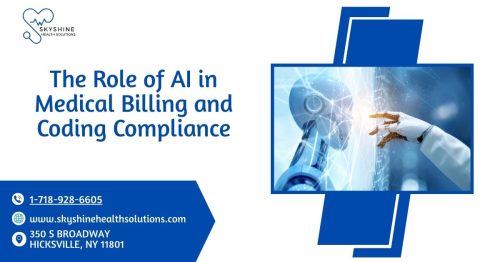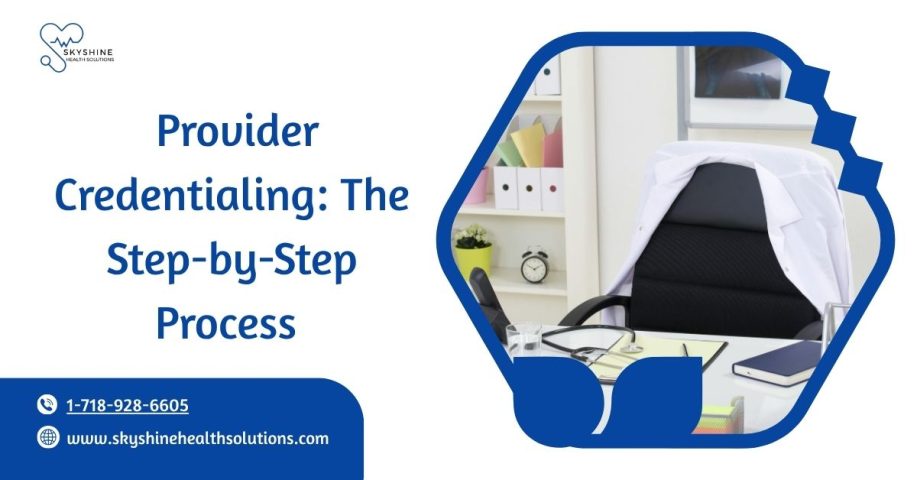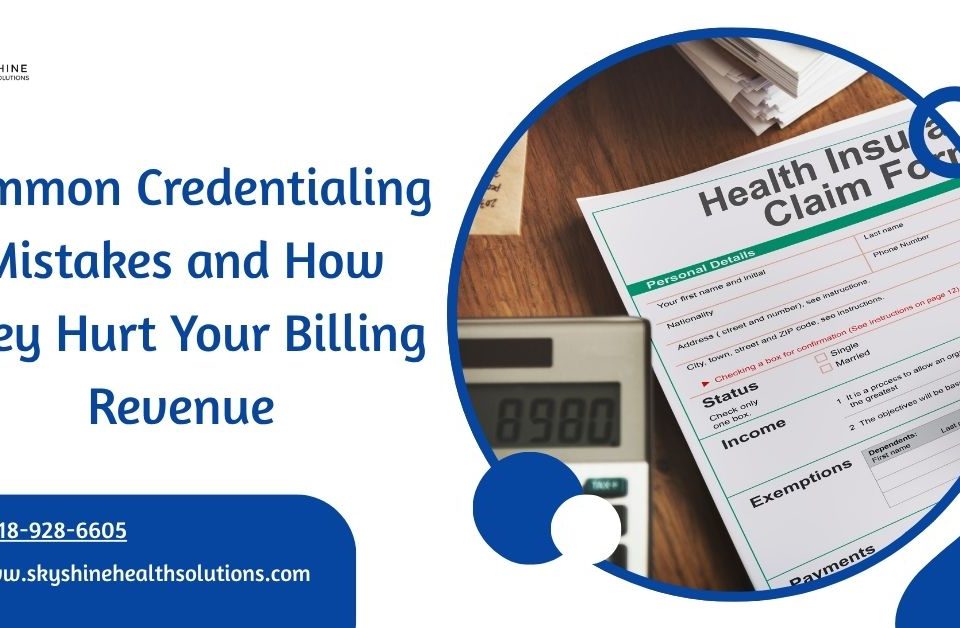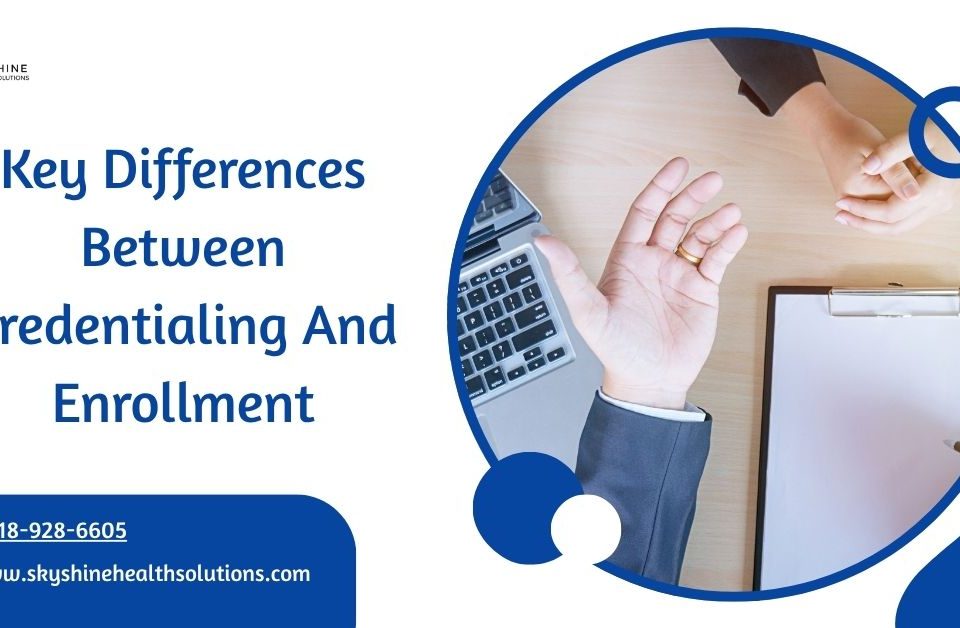
How AI is Transforming Denial Management in Medical Billing
September 29, 2025
Key Differences Between Credentialing And Enrollment
October 13, 2025In the ever-evolving landscape of healthcare, where patient trust and financial stability are paramount, provider credentialing is a cornerstone of practice success. As we move through 2025, with regulatory updates from CMS, CAQH enhancements, and increasing payer scrutiny, mastering the credentialing process is critical for healthcare providers to ensure seamless billing, compliance, and patient care. At Skyshine Health Solutions, a premier medical billing company, we’ve streamlined credentialing for countless practices, reducing timelines and boosting revenue by up to 40%. Our expertise in revenue cycle management (RCM) positions us to guide you through this complex process with precision.
Credentialing delays can cripple a practice’s cash flow, costing an estimated $7,000-$10,000 per week per provider in lost reimbursements. For new practices or those onboarding providers, navigating the maze of applications, verifications, and payer requirements can feel overwhelming. This 3000-word guide breaks down the provider credentialing process into actionable steps, offering insights into 2025 updates, practical tips to accelerate approvals, and strategies to avoid costly mistakes. Whether you’re a solo practitioner, a multi-specialty clinic, or a hospital administrator, this roadmap will empower you to streamline credentialing and optimize your billing operations. Let’s dive into the step-by-step process and explore how Skyshine can transform your credentialing experience.
Understanding Provider Credentialing: The Foundation of Medical Billing
Provider credentialing is the systematic process of verifying a healthcare professional’s qualifications, including education, training, licensure, and professional history, to ensure they meet the standards of hospitals, insurance payers, and regulatory bodies. It’s not just a formality—it’s a safeguard for patient safety, legal compliance, and financial viability. Without proper credentialing, providers cannot bill insurance companies, leading to claim denials, delayed payments, or reliance on out-of-pocket patient fees.
In 2025, credentialing has evolved with digital tools like CAQH ProView and updated CMS forms, yet it remains a time-intensive process, often spanning 90-150 days depending on payer complexity and provider type. For instance, Medicare’s 2024 consolidation of CMS-855 forms streamlined some aspects, but new requirements for Marriage and Family Therapists (MFTs) and Mental Health Counselors (MHCs) add layers of verification. The stakes are high: a single error can delay approvals by weeks, costing practices thousands in unbilled services.
For medical billing companies like Skyshine, credentialing is the linchpin of effective RCM. It ensures providers are enrolled with payers like Medicare, Medicaid, and private insurers (e.g., Aetna, Blue Cross), enabling accurate claim submissions. Without it, even flawless coding and billing efforts fall apart. This guide will equip you with a clear, step-by-step framework to navigate credentialing, minimize delays, and maximize reimbursements.
Why Credentialing Matters for Your Practice
Credentialing directly impacts a practice’s financial health and operational efficiency. Here’s why it’s non-negotiable:
1. Revenue Protection: Delays in credentialing can halt billing, with studies estimating losses of $100,000-$250,000 per provider during the waiting period. In 2025, with rising healthcare costs, these losses hit harder.
2. Payer Compliance: Insurers require credentialed providers to participate in networks. Non-compliance risks claim denials or exclusion from contracts, disrupting cash flow.
3. Patient Access: In-network status attracts more patients, as insured individuals prefer providers covered by their plans. Credentialing enhances practice growth and marketability.
4. Regulatory Adherence: Federal and state regulations, including CMS and OIG requirements, mandate verified credentials to prevent fraud and ensure patient safety.
Skyshine Health Solutions specializes in outsourcing credentialing, achieving a 98% first-pass approval rate and cutting timelines by 30-50%. By integrating credentialing with billing and denial management, we ensure a seamless RCM process, letting providers focus on care delivery.
The Step-by-Step Provider Credentialing Process
Below is a detailed breakdown of the nine key steps in the provider credentialing process, based on 2025 standards from sources like Symplr, Medwave, and CMS updates. Each step includes sub-tasks, timelines, tips, and pitfalls to help you navigate efficiently.
Step 1: Initial Application and Documentation Collection
The process begins with gathering a comprehensive set of documents to verify a provider’s identity and qualifications. This step is critical, as incomplete submissions are the leading cause of delays.
Sub-tasks:
-
- Compile state medical licenses, DEA registration, and Controlled Dangerous Substances (CDS) certificates.
- collect board certifications, specialty fellowship documents, and educational diplomas from accredited institutions.
- Secure proof of malpractice insurance with coverage details.
- Obtain the National Provider Identifier (NPI) number via the NPPES registry.
- Prepare a detailed Curriculum Vitae (CV) outlining work history, affiliations, and publications.
- Gather 2-3 peer references from colleagues or supervisors.
- For Medicare, complete the CMS-855I form (consolidated in 2024 to include CMS-855R for individual practitioners).
- Create or update a CAQH ProView profile, mandatory for most private payers.
2025 Updates: New provider types like MFTs and MHCs must verify specific counseling credentials under Medicare’s expanded eligibility rules. CMS also requires hospice certifying physicians to be enrolled or opted-out.
Timeline: 1-3 weeks, depending on document availability.
Tips:
-
- Use a digital document management system to organize and secure files.
- Start collecting documents during provider recruitment to save time.
- Ensure all licenses and certifications are active and unencumbered.
Pitfalls:
-
- Missing or expired documents (e.g., an outdated DEA license) can delay the process by 2-4 weeks.
- Failing to update CAQH profiles quarterly leads to rejections by payers like UnitedHealthcare.
Skyshine’s Approach: Our team conducts a pre-submission audit to catch gaps, ensuring 100% completeness before forwarding to payers or hospitals.
Deep Dive: The CAQH ProView platform, used by over 1,000 payers, streamlines data collection but requires meticulous updates. For example, a solo practitioner might spend 10-15 hours per payer application without automation. Skyshine’s proprietary software integrates CAQH updates, reducing this burden to under 2 hours per provider.
Step 2: Educational Verification (Primary Source Verification)
Primary Source Verification (PSV) confirms a provider’s academic credentials directly with the issuing institutions, ensuring no discrepancies or fraudulent claims.
Sub-tasks:
-
- Contact medical schools to verify degrees and graduation dates.
- Use services like the National Student Clearinghouse for faster processing.
- For international graduates, obtain Educational Commission for Foreign Medical Graduates (ECFMG) certification.Verify continuing
- education credits if required by specialty boards.
2025 Updates: Increased scrutiny on PSV due to rising healthcare fraud cases means secondary sources (e.g., transcripts) are no longer accepted. CMS and private payers demand direct institutional confirmation.
Timeline: 2-4 weeks, depending on institutional response times.
Tips:
-
- Request verifications during recruitment to preempt delays.
- Use secure, HIPAA-compliant portals for document transmission.
- Maintain a verification log for audit readiness.
Pitfalls:
-
- Slow responses from academic institutions can stall progress; follow up weekly.
- Mismatched names (e.g., due to marriage) can trigger discrepancies, requiring affidavits.
Skyshine’s Advantage: We leverage established relationships with verification bodies, cutting turnaround times by 20-30%. Our team also handles international credentials, navigating complexities like ECFMG requirements.
Step 3: Residency and Fellowship Verification
This step verifies a provider’s postgraduate training, ensuring they completed accredited residency or fellowship programs.
Sub-tasks:
-
- Contact residency program directors to confirm participation, dates, and performance.
- Use the AMA’s FREIDA database for quick program lookups.
- Verify board eligibility or certification through the American Board of Medical Specialties (ABMS).
- For mental health providers, confirm counseling-specific residencies per 2024 CMS rules.
2025 Updates: New Medicare requirements for MHCs emphasize verified counseling residencies, with detailed performance evaluations required.
Timeline: 2-4 weeks.
Tips:
-
- Request letters of good standing from program directors early.
- Ensure training aligns with the provider’s specialty to avoid payer queries.
- Cross-check with ABMS for board status updates.
Pitfalls:
-
- Gaps in training timelines (e.g., unexplained leaves) can raise red flags, requiring affidavits.
- Non-accredited programs may not qualify for certain payers.
Skyshine’s Expertise: Our team streamlines this step by pre-verifying training during onboarding, reducing delays by up to 50%. We also maintain a database of accredited programs for quick reference.
Step 4: Licensing and Certification Check
Verify all active licenses and certifications, ensuring no restrictions or expirations.
Sub-tasks:
-
- Check state medical licenses via state boards or databases like the Federation of State Medical Boards (FSMB).
- Confirm DEA and CDS registrations for prescribing authority.
- Query the National Practitioner Data Bank (NPDB) for disciplinary actions.
- Verify board certifications through ABMS or specialty boards.
2025 Updates: Medicare requires hospice certifying physicians to be enrolled or opted-out, with expanded ownership data for Skilled Nursing Facilities (SNFs).
Timeline: 1-2 weeks.
Tips:
-
- Set automated reminders for license renewals 90 days in advance.
- Use NPDB’s continuous query service for real-time updates.
- Cross-check license numbers for accuracy.
- Pitfalls:
- Expired licenses are a top rejection reason, delaying approvals by 4-6 weeks.
- Disciplinary actions not disclosed upfront can lead to denials.
Skyshine’s Solution: We integrate license tracking into our RCM platform, ensuring renewals are flagged early and compliance is maintained.
Step 5: Work History Review
Review the provider’s employment history, typically covering the past 5-7 years, to ensure continuity and credibility.
Sub-tasks:
-
- Contact former employers to verify positions, dates, and performance.
- Document hospital affiliations and privileges.
- Explain any gaps over 6 months with affidavits or supporting documents.
Timeline: 3-5 weeks.
Tips:
-
- Prepare a detailed CV with clear timelines to streamline verification.
- Use standardized forms for employer outreach to speed responses.
- Anticipate gaps due to personal reasons (e.g., maternity leave) and prepare explanations.
Pitfalls:
-
- Unexplained gaps can trigger payer scrutiny, delaying approvals.
- Unresponsive former employers can stall the process; multiple follow-ups are key.
Skyshine’s Edge: Our team uses automated outreach tools and a network of employer contacts to verify histories in under 3 weeks, compared to the industry average of 5 weeks.
Step 6: Malpractice History and Claims Review
Assess the provider’s malpractice history to identify risks and ensure transparency.
Sub-tasks:
-
- Query NPDB and insurance carriers for claims, settlements, or judgments.
- Disclose all incidents with explanations and resolutions.
- Evaluate coverage adequacy for the provider’s specialty.
Timeline: 2-3 weeks.
Tips:
-
- Maintain detailed records of closed claims to avoid surprises.
- Work with insurers to confirm coverage aligns with payer requirements.
- Be proactive in explaining settled claims to mitigate concerns.
Pitfalls:
-
- Undisclosed claims are a red flag, often leading to outright denials.
- Insufficient coverage can disqualify providers from certain networks.
Skyshine’s Support: We conduct thorough NPDB checks and liaise with insurers to ensure compliance, reducing rejection risks by 95%.
Step 7: Peer References and Background Checks
Obtain references and conduct background checks to confirm professional reputation and compliance.
Sub-tasks:
-
- Secure 2-3 references from peers or supervisors familiar with the provider’s work.
- Run criminal background checks via FCRA-compliant services.
- Check the OIG exclusion list to ensure no sanctions.
Timeline: 1-2 weeks.
Tips:
-
- Choose responsive referees who can provide detailed feedback.
- Use standardized reference forms to expedite responses.
- Verify OIG status monthly for ongoing compliance.
Pitfalls:
-
- Unresponsive referees can delay approvals by 2-3 weeks.
- Negative references or OIG exclusions can derail the process entirely.
Skyshine’s Process: We maintain a network of reliable referees and use automated background check tools, ensuring completion in under 10 days.
Step 8: Committee Review and Payer Submission
Submit the verified application to credentialing committees (for hospitals) or payers (for insurance networks).
Sub-tasks:
-
- For hospitals, present to the Medical Executive Committee (MEC) for approval.
- For payers, submit via CAQH or direct applications to insurers like Aetna or Cigna.
- Include all verified documents and supporting explanations.
2025 Updates: SNF revalidations now require detailed ownership and managerial data, increasing scrutiny.
Timeline: 4-8 weeks, depending on committee or payer response times.
Tips:
-
- Follow up bi-weekly to track progress and address queries.
- Ensure applications align with payer-specific requirements (e.g., Medicare’s PECOS system).
- Use tracking software to monitor submission status.
Pitfalls:
-
- Incomplete submissions can reset the review clock.
- Ignoring payer-specific forms (e.g., Cigna’s unique addendum) leads to rejections.
Skyshine’s Expertise: Our team submits to multiple payers simultaneously, using tailored templates to meet specific requirements, achieving approvals in as little as 4 weeks.
Step 9: Approval and Ongoing Maintenance
Once approved, maintain credentials through re-credentialing and updates.
Sub-tasks:
-
- Receive approval notifications and update practice records.
- Re-credential every 2-3 years, per payer or hospital policy.
- Update CAQH profiles quarterly and report changes (e.g., address, licensure) promptly.
Timeline: Ongoing.
Tips:
Pitfalls:
-
- Lapsed CAQH profiles can delay re-credentialing, disrupting billing.
- Failure to report changes (e.g., new affiliations) risks payer sanctions.
Skyshine’s Maintenance Plan: We provide continuous monitoring and re-credentialing services, ensuring 100% compliance with minimal effort from your team.
Accelerating the Credentialing Process: Expert Tips
To cut timelines from 120 days to as little as 60, consider these strategies:
-
- Start Early: Begin credentialing 4-6 months before a provider’s start date to account for delays.
- Leverage Technology: Use software like Symplr or Modio Health to centralize documents and track progress.
- Outsource to Experts: Partner with Skyshine Health Solutions to offload administrative burdens, achieving 30-50% faster approvals.
- Pre-Assess Providers: Verify credentials during recruitment to identify issues early.
- Follow Up Proactively: Contact payers and institutions weekly to keep applications moving.
In 2025, automation is key. Practices using digital credentialing platforms report 25% faster approvals compared to manual processes. Skyshine’s proprietary system integrates CAQH, PECOS, and payer portals, streamlining submissions and follow-ups.
Common Credentialing Mistakes and How to Avoid Them
Avoid these pitfalls to ensure smooth approvals:
-
- Incomplete Applications: Double-check all documents before submission. Skyshine’s pre-audit catches 99% of errors.
- Expired Licenses: Set renewal reminders 90 days in advance to prevent lapses.
- Outdated CAQH Profiles: Update quarterly to avoid payer rejections.
- Unexplained Gaps: Provide affidavits for employment or training gaps to preempt scrutiny.
- Ignoring Follow-Ups: Delays often stem from unanswered payer queries; respond within 48 hours.
A real-world example: A multi-specialty clinic lost $150,000 due to a lapsed CAQH profile, delaying approvals by 2 months. Skyshine’s proactive monitoring prevents such oversights.
The Skyshine Advantage: Why Outsource Credentialing?
Credentialing is time-consuming and error-prone, diverting resources from patient care. Skyshine Health Solutions offers a turnkey solution, handling all nine steps with unmatched efficiency. Our results speak for themselves:
-
- 98% First-Pass Approval Rate: Our meticulous process minimizes rejections.
- 40% Faster Timelines: We cut approval times from 120 to 60-80 days.
- End-to-End RCM Integration: Credentialing syncs seamlessly with billing and denial management.
- 2025 Compliance: We stay ahead of CMS, CAQH, and payer updates, ensuring zero compliance risks.
Conclusion: Streamline Credentialing for Practice Success
In 2025, provider credentialing remains a critical yet complex process that directly impacts your practice’s financial health. By following this nine-step roadmap—collecting documents, verifying credentials, submitting to payers, and maintaining compliance—you can minimize delays and maximize reimbursements. However, the administrative burden can overwhelm even the most organized practices.
That’s where Skyshine Health Solutions shines. Our expert team takes the hassle out of credentialing, delivering faster approvals, higher approval rates, and seamless integration with your billing operations. Ready to transform your revenue cycle? Contact Skyshine today for a free credentialing audit and discover how we can save you time and money.

Check our article on The Role of AI in Medical Billing and Coding Compliance
Call to Action: Visit Skyshine Health Solutions to schedule your free consultation and start optimizing your credentialing process today.















